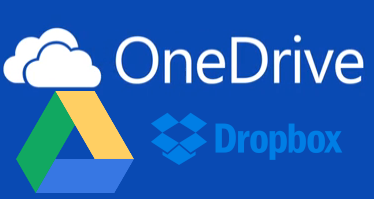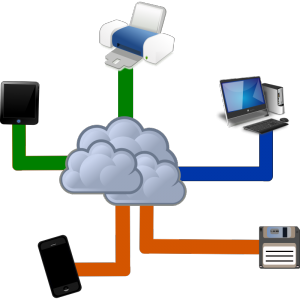In this inaugural edition of Tech Talk, I’ll be talking about clouds. (When the topic was first suggested, I thought, “no problem.” I had no idea that I’d write 1600 words about it. But here we are. I’m sure you’ll love each and every one of these 1600 words, too!)
I was going to go with the obvious joke1, and open with a definition of clouds, the kind you find in the sky. It turns out, scientists are somewhat murky on the details of what exactly constitutes a cloud. Who knew?
Much like meteorology’s clouds, defining a cloud when it comes to technology can be equally, well, cloudy2.
Phrases like “the cloud”, “cloud computing”, and “cloud storage” are often used. Almost all of us have used these technologies, whether we know it or not.
The term “cloud” has only really been around since the mid-2000s, but the actual concept has been around much, much longer. So what is it, why would you use it, and is it good or bad?
Essentially, the definition of “cloud” can be distilled into this: a group of computers on the Internet doing something together3.
And “cloud” breaks down into two distinctly different terms:

Cloud storage: a bunch of computers linked together for storage. OneDrive: cloud storage. Google Drive? Box.com? Dropbox? Cloud storage, all three. When you store a file in your OneDrive, you don’t know (or care) where it goes. It might end up on one of Microsoft’s servers in California. When you save another file, it might end up on an entirely different server in a completely different location, like New York. So cloud storage looks and acts like a single location, but is spread across many computer servers in many locations.

Cloud computing: a bunch of computers, uh, computing together4. This gets a bit trickier and more technical, but essentially, it’s the same as cloud storage, but instead of the storage being spread across many servers, computational power is being distributed. Amazon is one company that offers cloud computing services. A quick example: Let’s say I have a brilliant idea5 for a new web app that I think is going to take the world by storm, but I don’t have the money6 to deploy the number of servers it would take to accommodate the millions of users I just know are going to use it. For a reasonable price – reasonable in comparison to rolling out my own servers – Amazon will provide me with access to their servers. And not only that, but if my service grows, Amazon can – again, for a price – easily allocate more resources to my web app. The end result? I look like a big-time company like Twitter or Facebook, but I don’t own a single server myself. This is cloud computing.
“You’re explaining technology with technology. Stop that!”
Alright, let’s say you find a really great-sounding recipe for a pie, but you don’t feel like baking it yourself. So, you hire a pastry chef to bake you the pie. It is absolutely amazing, even better than you’d hoped! You eat the whole thing in one sitting, and feel enormous amounts of regret7 .
.
The next day, you invite a friend over, and you have the pastry chef make two pies, one for each of you. Yum! The pies are gone in no time.
 This pie is so awesome, you want to share it with everyone! So, you decide to invite over 200 of your closest friends for pie. The pastry chef says, politely but firmly, “I can’t possibly make 200 pies. I’m only one person, and you only have one oven, and only so many mixing bowls and spoons.”
This pie is so awesome, you want to share it with everyone! So, you decide to invite over 200 of your closest friends for pie. The pastry chef says, politely but firmly, “I can’t possibly make 200 pies. I’m only one person, and you only have one oven, and only so many mixing bowls and spoons.”
Chagrined, but determined to offer pie to the masses, you hire another 199 pastry chefs, and buy the entire stock of ovens from Lowe’s, Home Depot, that scratch-and-dent appliance place down the street, and some guy selling them out of an abandoned parking lot. Excitedly, you send out the 200 invitations, and on the day of the Great Pie Party, only 50 people show up.
Now, 150 of the pastry chefs are standing around with nothing to do except collect a paycheck. 150 of the ovens are left with that lonely, empty feeling.
 A better solution would be to hire a baking company to provide the pastry chefs and all the equipment, have them make the pies, and then deliver them to you8.
A better solution would be to hire a baking company to provide the pastry chefs and all the equipment, have them make the pies, and then deliver them to you8.
Great! Now someone else has to worry about having all those chefs and ovens and equipment and ingredients, and you can just pay for what you use; some days, that might be 5 chefs, and on other days, that might be 50 or 500 chefs. But you only pay for what you use each day, even if that amount fluctuates daily.
That’s cloud computing, only instead of pies, it’s some kind of Internet service, like a web app. You pay for what you use, when you need it. You can use a little, or a lot.
One final example, going back to technology: Picture a high school hosting their own Moodle server. It’s hosted at the school on a single server. What if they wanted to provide Moodle to all the schools in the district? They’d need a lot of servers for that, and a lot more bandwidth, and a lot more people to maintain those servers. What if they wanted to provide Moodle to all the schools and universities in the state, or the entire country? It would make much more sense to use cloud computing in this case – they wouldn’t know how many users there would be on any given day, but cloud computing would give them the space to grow as slowly or as quickly as needed.
We all use these things frequently. Compared to cloud storage, cloud computing is much more transparent, and harder to recognize.
If that makes sense, great! If not, that’s okay, too. Let’s move on to cloud storage, since it’s more critical that you understand that.
Cloud Storage
Historically, we have saved our electronic files in many places: floppy disks, USB flash drives, our local hard drives, or network drives on a file server. With OneDrive, and other forms of cloud storage, we have a new choice.
“So, OneDrive is the cloud?” Yes, OneDrive is the cloud. Or, more accurately, it’s a cloud, one of many.
Why save your files in OneDrive? Unlike a flash drive, you can’t lose it or break it or accidentally run it through the washing machine when you forget that it’s in your pants pocket. Unlike a computer’s hard drive, it won’t die when you least expect it, leaving you with nothing9. And unlike a network drive, your OneDrive is accessible anywhere, even if you’re using a different network or a computer at your house. As a bonus, when it comes to cloud storage, if more space is needed, it’s just the click of a mouse button (and swipe of a credit card) away.
With that said, here are the top three reasons why you SHOULDN’T save your files in OneDrive:
No, really. There’s almost no downside to using OneDrive instead of any other form of storage. If you use the OneDrive Sync tool, not only are your files stored in the cloud, they’re saved locally as well, so even on the rare occasion when OneDrive isn’t working, or you don’t have Internet access10, you can still access your files.
 I understand that some people don’t like having their “stuff out there on the Internet”. Think back to the recent news reports about “hacks” and stolen credit cards. Target’s security breach was its brick-and-mortar stores, not its online presence. Same with Home Depot. Both had their in-store point of sale systems breached or hacked. Neither had anything to do with using cloud storage.
I understand that some people don’t like having their “stuff out there on the Internet”. Think back to the recent news reports about “hacks” and stolen credit cards. Target’s security breach was its brick-and-mortar stores, not its online presence. Same with Home Depot. Both had their in-store point of sale systems breached or hacked. Neither had anything to do with using cloud storage.
With a strong password and two-factor authentication, your online information is less likely to be stolen than the physical credit card in your wallet11.
The number of backups and fail-safes that are in place far exceed anything Trinity could ever offer on their own, for monetary and practicality reasons.
If the power goes out at your school, the servers go offline after a short time. But with cloud storage, the servers are spread over a wide area, and aren’t likely to be affected by things like power outages or network disruptions.
Give it a try. Save some files in your OneDrive and see how it works for you. For me, it has made life much easier. I can access my work no matter where I am – in my office, in my classroom, or at home. Your files are available online or offline – it’s the best of both worlds.
Check out the cloud storage infographic here: http://goo.gl/7m2IBk
1I’m not ashamed to go for the low-hanging fruit.
2See?
3For some reason, people thought “cloud” would be a less cumbersome term
4Stick around for more brilliant analysis!
5Stranger things have happened.
6This part is true.
7But not so much regret that you don’t have more pie the very next day.
8The best solution is to stop eating so much pie!
9Like that rich uncle of yours when he wrote you out of his will.
10I lobbied the World Health Organization to include “high-speed Internet access” on their list of essential medicines, but they haven’t done so yet.
11This is just one person’s opinion, and no, I can’t back it up with facts. But I believe it to be true.